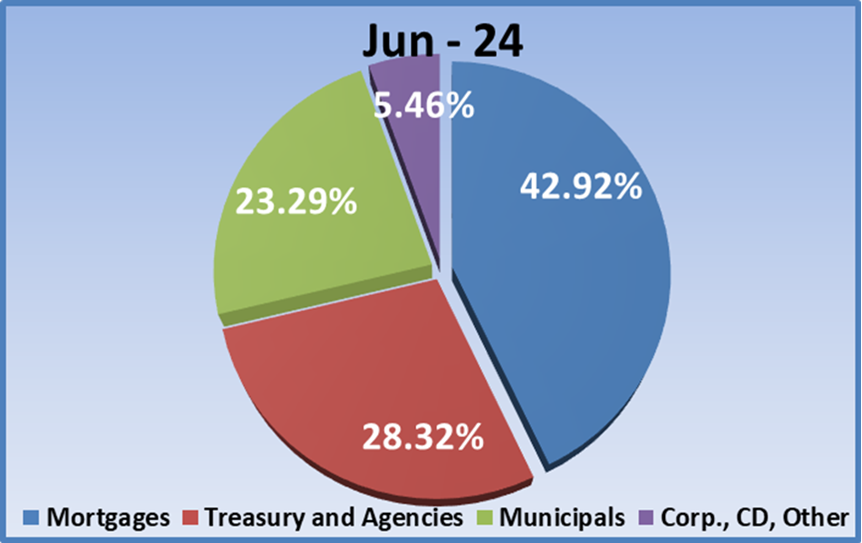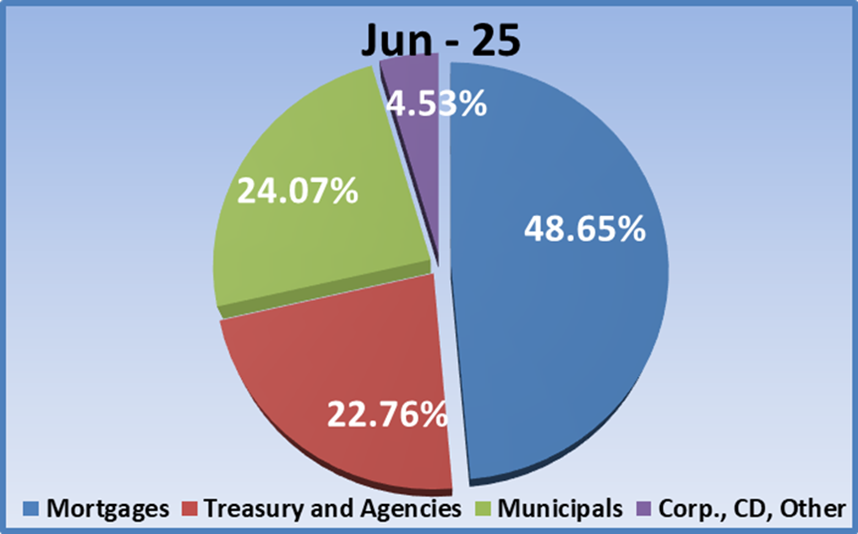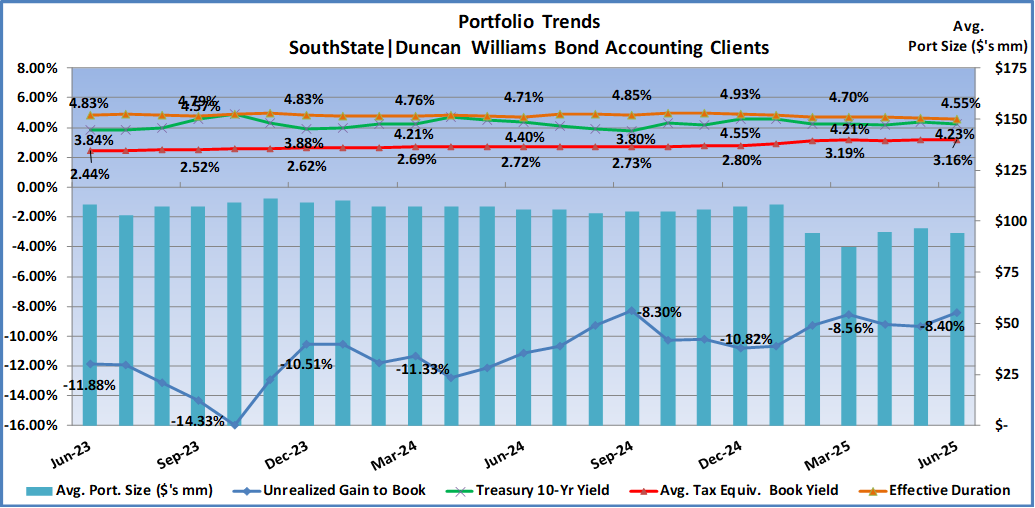Bond Portfolio Trends: Second Quarter 2025
Bond Portfolio Trends: Second Quarter 2025
Background
Beginning in May 2012, we started tracking portfolio trends of our bond accounting customers here at SouthState|DuncanWilliams. At present, we account for over 130 client portfolios with a combined book value of $12.3 billion (not including SouthState Bank’s portfolio), or $95 million on average per portfolio. Twelve months earlier, the average portfolio size was $106 million, an 10.3% decrease over the year. Average portfolio size peaked at $111 million in November 2023.
Second Quarter Market Observations
- The second quarter of 2025, like the first, was characterized by better inflation numbers vs. a year ago but fluctuating tariff policies kept uncertainty high regarding the future course of inflation. The shifting fiscal policies have kept the Fed on hold so far this year, and while consumer consumption has slowed from 2024’s torrid pace the consumer has not completely retreated. Yields were largely rangebound during the quarter as the competing narratives of docile inflation sparred with higher cost expectations via tariffs and an economy and labor market that still exhibited resilience.
- The Fed has stood pat since December and markets expect the next cut to come in September, but that’s still dependent on intervening data on the economy and inflation. When the year began, rate cut expectations were closer to 100bps but that has been dialed back with the latest forecast expecting two 25bps cuts by year-end.
- During the quarter, the 10yr Treasury yield ended 2bps higher, virtually unchanged, and the 2yr Treasury finished the quarter 17bps lower, as a September rate cut moved closer into view. With that backdrop, let’s turn our attention to changes in portfolio allocations during the past year.
Changes in Portfolio Allocations
- Let’s begin our portfolio review by revisiting allocations a year ago as shown in the pie chart below. The MBS/CMO sector comprised 43% of the portfolio, Agency/Treasury investments were 28%, municipal allocations stood at 23%, and the “Other” category (CDs, corporates, and other floaters) 5.5%.

- Fast forward one year to June 30, 2025. The MBS/CMO sector comprised 49% of the portfolio, a solid 6% increase from last year. This repeats the experience of the previous year which halted a prior multi-year trend of declining MBS allocations. Previous to the hiking cycle, MBS tended to lead portfolio investments by a wide margin, close to 50% of total allocations, and as you can see we are approaching that level again.
- The Agency/Treasury sector had been the one sector that experienced increased allocations during the hiking cycle, but for the seventh straight quarter allocations declined from 28.3% a year ago to 22.8%, a 5.5% decline as the MBS and to a lesser degree munis continued to entice investors back to those traditionally leading sectors. The “Other” category was slightly smaller at 4.5% versus 5.5% a year ago with corporate bonds constituting more than 80% of the sector.
- The decrease in municipal investments that had been a feature for much of 2023 stopped in the fourth quarter of that year and that modest increase in allocation continued throughout 2024. During the first half of this year, that tentative increase in muni allocation has continued. The slightly higher investment over the past year is an improvement over the run-off that had been a feature once the hiking cycle started in March 2022.

Changes in Portfolio Performance
Now let’s look at portfolio performance trends. The graph below tracks average portfolio tax-equivalent book yield, duration, and unrealized gain/(loss) as a percent of book value. It also tracks 10-year Treasury yields and average portfolio size over the last two years.

- Portfolio yields averaged 2.72% (red line) a year ago. Yields have risen through the year as reinvestments were made at higher market yields, albeit on a modest basis. By the second quarter, yields had increased 44bps over the year ago rate to 3.16%, and improved 36bps during the first half of the year. We had been typically seeing 7 to 8bps in quarterly yield improvement over the last two years so this recent increase of nearly 11bps per quarter reflects a slightly more aggressive investment posture.
- 10-year Treasury yields (green line) a year ago were 4.40% and 4.55% at year-end 2024. Competing concerns over slowing growth and higher costs via tariffs kept yields more range bound in the second quarter as the 10yr yield finished the quarter at 4.23%, a whopping 2bps increase during the quarter.
- Durations a year ago averaged 4.71 years and trended higher during the second half of 2024 as higher rates slowed prepayment and call expectations, peaking at 4.93 years at year-end. Durations ended the second quarter at 4.55 years as lower short-term rates and shorter-duration purchases aided the move lower during the quarter. The average duration is now the lowest since November 2021 and well off the 5.50 year high when rate hikes were beginning in March 2022.
- With the decrease in duration and modest decrease in shorter-term interest rates during the quarter unrealized losses improved. Unrealized losses during the quarter decreased from –8.56% to –8.40% as a percent of book, slightly worse than the –8.30% loss in the third quarter of 2024, which stands as the lowest unrealized loss since March 2022, when the Fed began its hiking cycle. The cycle low remains the –16.00% unrealized loss in October 2023.
Portfolio Purchases During the Second Quarter 2025
- New investments during the quarter decreased from $1.024 billion in the first quarter to $971 million, or $7.5 million on average per portfolio. By way of comparison, in the second quarter 2024, purchases totaled $501 million. So, purchases, in general, continue to accelerate as the Fed shifted from rate hikes to cuts in late 2024. However, the run rate of purchases prior to the pandemic was approximately $1.2 billion per quarter, so still trailing the pre-pandemic pace.
- After ten straight quarters leading new allocations, the Treasury/agency sector, and the MBS/CMO/SBA category have been swapping places since the third quarter of 2024 leading new investments. The Treasury/agency sector stormed back into the lead in the second quarter this year. Investments in the sector accounted for 66% of total purchases (61% Treasury, 5% agency). The 66% in new purchases compares to a legacy total of 23%. The MBS/CMO/SBA sector followed with 27% of total purchases. The municipal sector was once again lapped by the top two categories with 5.3% of purchases, ( 2.8% tax-free, 2.5% taxable). The 5.3% in muni purchases compares to a 24% legacy muni allocation.
- Average tax-equivalent book yield for second quarter purchases was 4.34% vs. 4.71% the prior quarter. The average effective duration was 2.10 years versus 2.31 years in the prior quarter. So, investors gave up some yield vs. the first quarter but shorter duration purchases helped lower overall portfolio duration. Negative convexity was 0.01 versus –0.31 in the prior quarter. Compare those figures to the legacy portfolio book yield of 3.16% and effective duration of 4.55 years.
- We’ll be back in October with a review of third quarter performance and purchases as banks prepare for the calendar turn and a new Fed Chair by mid-year.
Securities offered through the SouthState | DuncanWilliams 1) are not FDIC insured, 2) not guaranteed by any bank, and 3) may lose value including a possible loss of principal invested. SouthState | DuncanWilliams does not provide legal or tax advice. Recipients should consult with their own legal or tax professionals prior to making any decision with a legal or tax consequence. The information contained in the summary was obtained from various sources that SouthState | DuncanWilliams believes to be reliable, but we do not guarantee its accuracy or completeness. The information contained in the summary speaks only to the dates shown and is subject to change with notice. This summary is for informational purposes only and is not intended to provide a recommendation with respect to any security. In addition, this summary does not take into account the financial position or investment objectives of any specific investor. This is not an offer to sell or buy any securities product, nor should it be construed as investment advice or investment recommendations.
